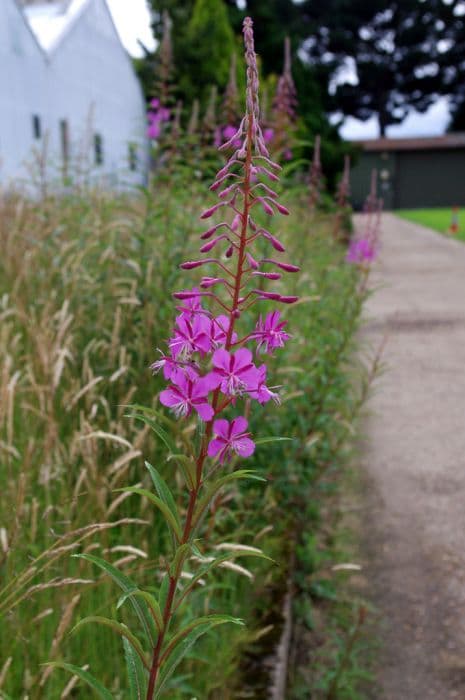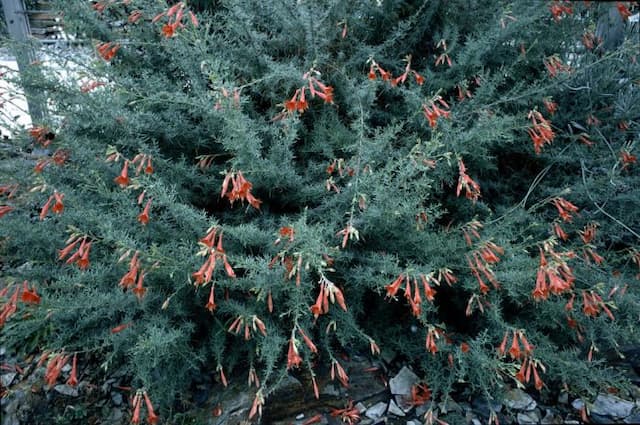Fuchsia Fuchsia 'Voodoo' (d)

ABOUT
The Fuchsia 'Voodoo' is a captivating plant known for its unique and striking flowers. This variety features dramatic blooms that are a blend of dark red and purple hues, hanging gracefully from the stems like delicate earrings. The petals are long and slender, while the sepals—the outer parts of the flower—curl elegantly backwards. The flowers dangle in clusters, creating a showy display that can catch anyone's eye. The foliage of the Fuchsia 'Voodoo' contrasts with the vivid flowers. The leaves are a deep, glossy green with a slightly serrated edge, providing a lush background that makes the flowers stand out even more. The stems are also graceful, often arching or trailing, which makes this plant a favorite choice for hanging baskets where the full splendor of its pendulous flowers can be admired. Overall, the appearance of Fuchsia 'Voodoo' is characterized by its vibrant, showy flowers and rich green foliage, which come together to create a stunning visual spectacle. This plant is a true statement piece in any garden or landscape where its flowers can truly show off their enchanting dance.
About this plant
 Names
NamesFamily
Onagraceae
Synonyms
Lady's Eardrops, Fuchsia
Common names
Fuchsia 'Voodoo'
 Toxicity
ToxicityTo humans
Fuchsia plants, in general, are not considered toxic to humans. However, if large quantities are ingested, they may cause mild digestive discomfort. There is no significant risk of serious poisoning from the Fuchsia 'Voodoo'.
To pets
Fuchsia plants are also not typically toxic to pets. If a pet consumes a small amount of the plant, it is unlikely to cause harm. However, as with humans, ingesting large quantities could potentially result in mild gastrointestinal upset such as vomiting or diarrhea. No severe toxicity is expected from the Fuchsia 'Voodoo' to pets.
 Characteristics
CharacteristicsLife cycle
Perennials
Foliage type
Deciduous
Color of leaves
Green
Flower color
Mixed
Height
2 feet (0.61 meters)
Spread
2 feet (0.61 meters)
Plant type
Shrub
Hardiness zones
9
Native area
Central America
Benefits
 General Benefits
General Benefits- Decorative Appeal: Fuchsia 'Voodoo' produces striking and colorful flowers that can enhance the aesthetic of gardens, patios, and indoor spaces.
- Attracts Pollinators: The plant is known to attract hummingbirds and butterflies, contributing to pollination in the garden.
- Versatility: It can be grown in containers, hanging baskets, or as bedding, offering various landscaping options.
- Long Blooming Period: This fuchsia variety has a long flowering season, providing color from spring to fall.
- Shade Tolerance: Unlike many flowering plants, it can thrive in partially shaded conditions, ideal for gardens with limited sunlight.
- Easy Propagation: Fuchsia 'Voodoo' can be easily propagated from cuttings, allowing gardeners to create more plants for use in other areas or to share with others.
 Medical Properties
Medical PropertiesThis plant is not used for medical purposes.
 Air-purifying Qualities
Air-purifying QualitiesThis plant is not specifically known for air purifying qualities.
 Other Uses
Other Uses- Fuchsia 'Voodoo' can be used in jewelry making; its striking flowers inspire designs for earrings, necklaces, and brooches.
- The blossoms of Fuchsia 'Voodoo' can serve as a natural dye, providing a unique pinkish-purple hue to fabrics and textiles.
- In culinary arts, the edible flowers add a vibrant touch and a slightly acidic flavor to salads, desserts, and cocktails.
- The plant can be incorporated into crafting, where the flowers are dried and utilized in scrapbooking or card making for a 3D effect.
- In photography, Fuchsia 'Voodoo' provides an attractive lure for hummingbirds, thus helping photographers capture these elusive birds in action.
- Entomology enthusiasts may use Fuchsia 'Voodoo' in their gardens to attract and study various butterfly and bee species.
- As a color inspiration, artists can use the vivid flowers of Fuchsia 'Voodoo' as a muse for paintings, textiles, and interior design palettes.
- The blossoms can be floated in large decorative bowls of water as part of a table centerpiece for events and receptions.
- Fuchsia 'Voodoo' can act as a living art installation, where the plants are arranged creatively in public spaces or galleries to complement urban art projects.
- Gardeners might engage in topiary practices with Fuchsia 'Voodoo', training the flexible branches into ornamental shapes and designs.
Interesting Facts
 Feng Shui
Feng ShuiThe fuchsia is not used in Feng Shui practice.
 Zodiac Sign Compitability
Zodiac Sign CompitabilityThe fuchsia is not used in astrology practice.
 Plant Symbolism
Plant Symbolism- Confidence: The bold color of fuchsia flowers represents confidence and assertiveness.
- Maturity: Fuchsia's elaborate blossoms symbolize a level of maturity and elegance due to their intricate and poised appearance.
- Harmony: The plant's ability to blend various colors seamlessly embodies harmony and balance.
- Good Taste: Often found in ornamental gardens, fuchsia is a symbol of good taste and discernment in beauty.
- Energetic Vibrancy: The vibrant hues and lively shape of the plant’s flowers represent an energetic and joyful spirit.
 Water
WaterFuchsia, commonly known as Lady's Eardrops, demands consistent moisture without being waterlogged. Water the plant when the top inch of the soil feels dry to the touch, which typically translates to approximately once or twice a week. Use lukewarm water and gently pour around the base of the plant until the water begins to run out of the bottom of the pot, indicating it has reached the root zone. Depending on the size of the plant and pot, this might mean using roughly 16 to 32 ounces each watering session. During the growing season in spring and summer, Lady's Eardrops might require more frequent watering compared to the cooler, dormant winter months.
 Light
LightLady's Eardrops prefer bright, indirect light with protection from the harsh afternoon sun. The best spot for these plants is a location where they can receive morning sunlight and dappled shade in the afternoon. An east-facing or north-facing window would be ideal indoors, while a spot with some protection, like under a tree canopy, is good for outdoor plants.
 Temperature
TemperatureLady's Eardrops thrive best in a temperature range of 60 to 70 degrees Fahrenheit. They can tolerate a minimum of 55 degrees Fahrenheit and a maximum of 75 degrees Fahrenheit but prefer cooler conditions. Exposing the plant to temperatures outside this range can cause stress and impede growth. The plant is sensitive to sudden temperature changes and strong cold drafts.
 Pruning
PruningPruning Lady's Eardrops is important for maintaining a bushy habit and encouraging prolific blooming. Prune lightly throughout the growing season to remove dead or broken stems and faded flowers, which also helps prevent disease. The best time for a major prune is in late winter or early spring before new growth begins.
 Cleaning
CleaningAs needed
 Soil
SoilFuchsia 'Voodoo' thrives in a well-draining soil mix with peat moss and perlite or sand; it prefers slightly acidic to neutral pH, around 6.0 to 7.0.
 Repotting
RepottingFuchsias like 'Voodoo' should typically be repotted every 2-3 years, or when rootbound, to provide fresh soil and encourage growth.
 Humidity & Misting
Humidity & MistingFuchsia 'Voodoo' prefers high humidity levels, ideally between 60-70%, to maintain healthy growth and vibrant blooms.
 Suitable locations
Suitable locationsIndoor
For Fuchsia 'Voodoo', provide bright, indirect light and consistent moisture.
Outdoor
Hang in partial shade; shelter from strong winds and hot sun.
Hardiness zone
10-11 USDA
 Life cycle
Life cycleThe Fuchsia 'Voodoo', commonly known as Voodoo Fuchsia, begins its life cycle when seeds germinate, typically requiring a moist, well-draining soil and some warmth to sprout. After germination, the seedlings emerge and grow into young plants with a distinctive set of leaves, which further mature to form the unique foliage and structure characteristic of Fuchsias. As mature plants, Voodoo Fuchsias produce striking, pendulous flowers with a bold blend of dark purple and red hues, which attract pollinators like hummingbirds and bees. Once pollinated, the flowers develop into small fruit that contain seeds, completing the reproductive stage. In temperate regions, Voodoo Fuchsia grows actively during the spring and summer, often entering a dormant phase in winter where it might shed leaves depending on the severity of the climate. With proper care, which includes pruning, feeding, and frost protection, Voodoo Fuchsias can live for several years, going through multiple flowering cycles within their perennial life span.
 Propogation
PropogationPropogation time
Spring-Early Summer
Propogation: The most popular method for propagating Fuchsia 'Voodoo' is through softwood cuttings. This process usually takes place in spring when the new growth is plentiful and the stems are neither too young nor too mature. To undertake this method, take a cutting of about 2 to 4 inches (5 to 10 centimeters) long from a healthy Fuchsia 'Voodoo' plant, making sure there are at least two or three sets of leaves. Remove the bottom leaves to expose a clear stem, which you then dip into a rooting hormone to encourage root development. Plant the cutting into a pot with a mixture of peat and perlite, ensuring high humidity and warmth, but avoid direct sunlight which can be too intense. New roots typically form within a few weeks, after which the cutting can be transferred to a larger pot or into the garden.









